Widgetized Section
Go to Admin » Appearance » Widgets » and move Gabfire Widget: Social into that MastheadOverlay zone
Reviewing The Sig MCX
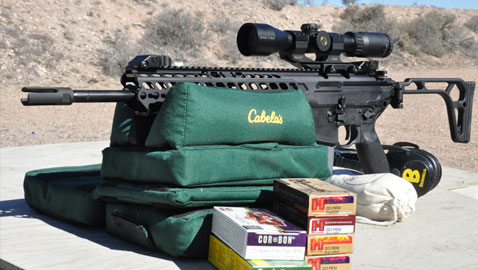 Originally designed as a military carbine meant to shoot the 300 Blackout cartridge with a silencer, the Sig MCX is now available in .223/5.56 NATO as well as 7.62X39. Along with the various calibers, the MCX can be had in a pistol or short-barreled rifle (9 inch) version and a number of stock configurations can be installed. The user can easily switch barrels and stocks without the need for special training or tools. Sig refers to this as a Mission Configurable Weapons System and you can tell by the quality of the various parts and the ease with which they go together that a lot of thought went into creating this concept.
Originally designed as a military carbine meant to shoot the 300 Blackout cartridge with a silencer, the Sig MCX is now available in .223/5.56 NATO as well as 7.62X39. Along with the various calibers, the MCX can be had in a pistol or short-barreled rifle (9 inch) version and a number of stock configurations can be installed. The user can easily switch barrels and stocks without the need for special training or tools. Sig refers to this as a Mission Configurable Weapons System and you can tell by the quality of the various parts and the ease with which they go together that a lot of thought went into creating this concept.
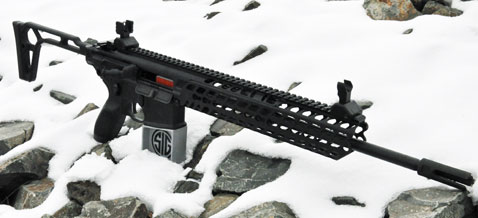
The rifle/carbine I was sent for testing is chambered in 5.56 and has a thin profile 16-inch barrel with a 1:7 rate of twist. My example is semi-automatic, however select fire (full auto) versions are available. Weighing only 6 pounds unloaded the MCX is the lightest gas piston AR variant I have tested. The two-position gas system is adjusted through a port in the key mod rail using the tip of a cartridge to set it for normal or suppressed firing. My example has a folding stock; sliding, fixed and arm brace stocks are available as well and they are attached to the rear of the receiver via a piece of Picatinny rail. Overall length comes to 35.25 inches with the stock in firing position and just under 27” with the stock folded to the side. With the exception of the bolt catch/release all other controls are ambidextrous. These include the selector switch, magazine release and charging handle. The rifle ships with a set of flip up metallic sights. The front sight is adjustable for elevation in the usual turning post/AR style; the rear sight has two apertures and is adjustable for windage by means of a knob. While the lower portion of the key mod rail is easily removed the upper rail is a monolithic part of the upper receiver offering about 19 inches of rail for mounting scopes, sights and accessories. Additional pieces of Picatinny rail can be attached to the handguards and the rifle ships with a short section. This system makes it easy to attach bipods, lights, lasers, handles and the like – I’m pretty sure someone has a can opener available. Don’t laugh; I’ve seen a chain saw, among other items, attached to a rail.
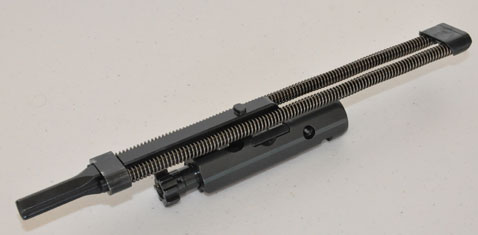
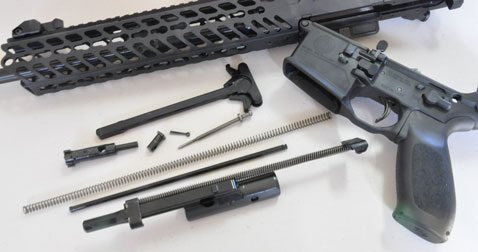
Anyone familiar with AR-type rifles will have little difficulty understanding the MCX but there are a few quirks. To start with, there is no buffer tube, buffer and spring. While the bolt, firing pin, cam pin and firing pin retaining pin will be familiar the bolt carrier is entirely different, as it contains dual recoil springs, spring rods and the op rod for the piston. Disassembly is easy but you should read the manual and study the illustrations before attempting it. The upper and lower receivers separate in the usual fashion after pushing the push-pins to the right. As far as I can tell, the trigger parts in the lower receiver are straight out of the AR parts catalog and I assume after-market triggers can be installed. And that’s a good thing, because the “mil-spec” trigger installed in the rifle is terrible. While not as gritty and crunchy as some I’ve encountered it breaks at over 10 pounds although Sig says it’s spec’d at 6.6 to 8.6 pounds.
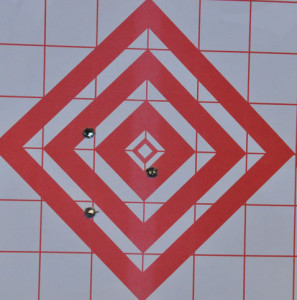 The trigger became a bit of a problem when I tested the MCX for accuracy at 100 yards. I fired the rifle off sandbags using a shorter, 20 round magazine rather than the military style 30 rounder that ships with the rifle. I installed a Burris XTR 1.5-6 illuminated reticle scope in the excellent P.E.P.R. mount on the rifle. This is my “go-to” testing setup for ARs (Burris has discontinued this particular scope). Shooting a variety of .223 and 5.56 factory ammunition I experienced 100% reliability with 3 shot groups averaging about 1.5 inches. I say “about” because some groups were a little bigger and some were smaller, but overall the average was what I have come to expect from 16 inch barreled AR style rifles with this scope combination. Yes, I could have tested the rifle with a high magnification target scope and might have shot better groups but that’s not the way I envision it being set up for most users. The other limiting factor to accuracy is the aforementioned heavy trigger, but hey, 1.5 MOA accuracy with a light barreled carbine is more than good enough for its intended role.
The trigger became a bit of a problem when I tested the MCX for accuracy at 100 yards. I fired the rifle off sandbags using a shorter, 20 round magazine rather than the military style 30 rounder that ships with the rifle. I installed a Burris XTR 1.5-6 illuminated reticle scope in the excellent P.E.P.R. mount on the rifle. This is my “go-to” testing setup for ARs (Burris has discontinued this particular scope). Shooting a variety of .223 and 5.56 factory ammunition I experienced 100% reliability with 3 shot groups averaging about 1.5 inches. I say “about” because some groups were a little bigger and some were smaller, but overall the average was what I have come to expect from 16 inch barreled AR style rifles with this scope combination. Yes, I could have tested the rifle with a high magnification target scope and might have shot better groups but that’s not the way I envision it being set up for most users. The other limiting factor to accuracy is the aforementioned heavy trigger, but hey, 1.5 MOA accuracy with a light barreled carbine is more than good enough for its intended role.
If you’re looking for a multi-caliber, multi-configuration capable carbine the MCX is it. The usual Sig quality is apparent throughout and the suggested retail price of under $1900 is in line with what you would expect to pay for other high quality piston guns. This is a nice rifle and I’m betting Sig has customers standing in line to get their hands on a MCX.
About the Author:
 Ed Head is a regular on Shooting Gallery, Gun Stories and Down Range TV. He has worked for almost 30 years in law enforcement, first in the United States Air Force and then with the United States Border Patrol, retiring as a Field Operations Supervisor. During his Border Patrol career, Ed worked in a variety of patrol, investigative and training capacities. Ed has an extensive background as a firearms instructor, having trained thousands, ranging from beginners to police, military and special operations personnel. Having taught at Gunsite for 20 years, Ed first trained there under the world famous shooting school’s founder, Jeff Cooper, then later ran the school as the operations manager for more than five years. Ed lives in Chino Valley, Arizona, where he continues to teach and write.
Ed Head is a regular on Shooting Gallery, Gun Stories and Down Range TV. He has worked for almost 30 years in law enforcement, first in the United States Air Force and then with the United States Border Patrol, retiring as a Field Operations Supervisor. During his Border Patrol career, Ed worked in a variety of patrol, investigative and training capacities. Ed has an extensive background as a firearms instructor, having trained thousands, ranging from beginners to police, military and special operations personnel. Having taught at Gunsite for 20 years, Ed first trained there under the world famous shooting school’s founder, Jeff Cooper, then later ran the school as the operations manager for more than five years. Ed lives in Chino Valley, Arizona, where he continues to teach and write.



 MidwayUSA
MidwayUSA Ruger Firearms
Ruger Firearms SCCY Firearms
SCCY Firearms Streamlight
Streamlight Action Targets
Action Targets Gunsite Academy
Gunsite Academy
You must be logged in to post a comment Login